Topics
Category
Era
Native American Boarding Schools
Native American boarding schools, which operated in Minnesota and across the United States beginning in the late nineteenth century, represent a dark chapter in U.S. history. Also called industrial schools, these institutions prepared boys for manual labor and farming and girls for domestic work. The boarding school, whether on or off a reservation, carried out the government's mission to restructure Native people's minds and personalities by severing children’s physical, cultural, and spiritual connections to their tribes.
On March 3, 1891, Congress authorized the Commissioner of Indian Affairs to create legal rules that required Native children to attend boarding schools. It also authorized the Indian Office to withhold rations, clothing, and other annuities from Native parents or guardians who would not send and keep their children in school. Indian Agents forcibly abducted children as young as four from their homes and enrolled them in Christian- and government-run boarding schools beginning in the mid-1800s and continuing into the 1970s.
Captain Richard H. Pratt’s boarding school experiment began in the late nineteenth century. A staunch assimilationist, Pratt advocated a position that diverged slightly from the white majority’s. Convinced of the U.S. government’s duty to “Americanize” Native people, he offered a variation of the slogan—popular in the American West— that stated the only good Indian was a dead one. The proper goal, Pratt claimed, was to “kill the Indian…and save the man.”
Pratt founded a school in 1879 at the site of an unused cavalry barracks at Carlisle, Pennsylvania, organizing the institution along rigid military lines. Pratt's program of half days in the classroom and half days spent at some form of manual labor soon became standard boarding school curriculum. Government expenditures for boarding schools were always small, and the schools exploited the free labor of Native children in order to function.
Minnesota had sixteen boarding schools that drew students from all eleven of the state’s reservations. The earliest was White Earth Indian School, begun in 1871. In 1902, St. Mary’s Mission boarded an average of sixty-two students, Red Lake School seventy seven, and Cross Lake forty two. At Morris, more than two thousand children attended the school during its history. White Earth had room for 110 students. Clontarf housed an average of 130 children from reservations in Dakota Territory. By 1910, Vermilion Lake held 120 students. Cass/Leech Lake opened with a capacity of fifty students. Pipestone housed children from Dakota, Oneida, Potawatomi (Bodéwadmi), Arikara, and Sac and Fox (Sauk and Meskwaki) tribes.
A typical daily schedule began with an early wake-up call at 5:45 am, most often announced by a bugler or bells. Students marched from one activity to the next. Every minute of the day was scheduled; mornings began with making beds, brushing teeth, breakfast, and industrial call (“detail”). School began around 9 am. Afternoons were spent in school and industrial work, which were followed by supper, up to thirty minutes of recreation, a call to quarters, and “tattoo.” Pupils retired to the sounds of taps at 9 pm.
Methods of discipline at Minnesota boarding schools were harsh. Some schools had cells or dungeons where students were confined for days and given only bread and water. One forced a young boy to dress like a girl for a month as a punishment; another cut a rebellious girl’s hair as short as a boy’s. Minnesota boarding schools recorded epidemics of measles, influenza, blood poisoning, diphtheria, typhoid, scarlet fever, tuberculosis, pneumonia, trachoma, and mumps, which swept through overcrowded dormitories. Students also died from accidents such as drowning and falls.
Boarding school staff assigned students to “details”: working in the kitchen, barns, and gardens; washing dishes, tables, and floors; ironing; sewing; darning; and carpentry. The schools also extensively utilized an “outing” program that retained students for the summer and involuntarily leased them out to white homes as menial laborers.
One of Minnesota’s most famous boarding school survivors is Native American activist Dennis Banks. When he was only four years old, Banks was sent three hundred miles from his home on the Leech Lake Reservation of Ojibwe, in Cass County, to the Pipestone Indian School. Lonesome, he kept running away but was caught and severely beaten each time. Another student, at St. Benedict’s, recalled being punished by being made to chew lye soap and blow bubbles that burned the inside of her mouth. This was a common punishment for students if they spoke their tribal language.
Many students’ parents and relatives resisted the boarding school system. In letters sent to absent children, they delivered news from home and tried to maintain family ties. In messages sent to school administrators, they arranged visits, advocated for improved living conditions, and reported cases of malnourishment and illness.
In 1928, the U.S. government released the Meriam Report, an evaluation of conditions on Native American reservations and in boarding schools. The critical study called the schools grossly inadequate. It presented evidence of malnourishment, overcrowding, insufficient medical services, a reliance on student labor, and low standards for teachers. As a result, the government built day schools on reservations. The original boarding schools began closing their doors as parents increasingly kept their children at home. By the end of the 1970s, most of them had shut down. As of 2016, though tribes and the Bureau of Indian Education (BIE) continue to run fifty schools nationwide, no Native boarding schools remain open in Minnesota.
There has been scant recognition of the boarding school era by the U.S federal government and church denominations that initiated and carried out the schools’ policies. Neither has acknowledged, as the Canadian government did for its own boarding school program in 2008, that those policies’ purpose was cultural genocide or accepted responsibility for their effects. Pratt’s contemporaries viewed him and other enforces of assimilationist policies as heroes. A few Minnesota institutions, such as St. Benedict's Monastery in St. Joseph, have apologized to the Native people they harmed.
Few textbooks discussed Native boarding schools before the twenty-first century. In the 2000s, however, many historians study them as the tools of ethnic cleansing. The genocidal policies the schools’ staffs carried out aimed to destroy the essential foundations of the lives of American Native students. Their objective was the disintegration and destruction of the culture, language, and spirituality of the Native American kids under their care. The policies they implemented led to the deaths of thousands of students through disease, hunger, and malnutrition, and have left a legacy of intergenerational trauma and unresolved grieving in many boarding school survivors and their families across Indian country.
Bibliography
Adams, David. Education for Extinction: American Indians and the Boarding School Experience, 1875–1928. Lawrence, KS: University Press of Kansas, 1995.
Archuleta, Margaret, Brenda Child, and Tsianina Lomawaima, eds. Away From Home: American Indian Boarding School Experiences, 1879–2000. Phoenix, AZ: Heard Museum, 2000.
Bah, Alberta Yeo. "Education Among Native Americans in the Periods Before and After Contact with Europeans: An Overview." Paper presented at the annual National Association of Native American Studies conference, Houston, Texas, 2005.
Child, Brenda. Boarding School Seasons: American Indian Families, 1900–1940. Lincoln, NE: University of Nebraska Press, 2000.
Cooper, Michael. Indian School: Teaching the White Man’s Way. New York: Clarion Books, 1999.
Feagin, Joe, and Clariece Feagin. Racial and Ethnic Relations. Englewood Cliffs, NJ: Prentice Hall, 2003.
Gunderson, Dan. "A Reckoning: St. Benedict Nuns Apologize for Native Boarding School." MPR News, October 26, 2021.
https://www.mprnews.org/story/2021/10/26/a-reckoning-monastic-order-apologizes-for-native-boarding-school
Horne, Esther, and Sally McBeth. Essie’s Story: The Life and Legacy of a Shoshone Teacher. Lincoln, NE: Bison Books, 1999.
Littlefield, Alice. "Learning to Labor: Native American Education in the United States, 1880–1930." In The Political Economy of North American Indians, edited by John Moor. Norman, OK: University of Oklahoma Press, 1993.
Lomawaima, Tsianina. "Domesticity in the Federal Indian Schools: The Power of Authority Over Mind and Body." American Ethnologist 20, no. 2 (1993): 1–14.
——— . They Called it Prairie Light: The Story of Chilocco Indian School. Lincoln, NE: University of Nebraska Press, 1994.
Pratt, Richard H. Battlefield and Classroom: Four Decades With the American Indian, 1867–1904. Robert M. Utley, ed. Norman, OK: University of Oklahoma Press, 2003.
——— . “The Advantages of Mingling Indians with Whites.” In Americanizing the American Indians: Writings by the “Friends of the Indian,” 1880–1900. Cambridge, MA: Harvard University Press, 1973.
Smith, Andrea. Conquest: Sexual Violence and American Indian Genocide. Cambridge, MA: South End Press, 2005.
Statutes at Large of the United States of America. 1891.
Trafzer, Clifford, Jean Keller, and Lorene Sisquoc, eds. Boarding School Blues: Revisiting American Indian Educational Experiences. Lincoln, NE: University of Nebraska, 2006.
Utley Robert, ed. Battlefield and Classroom: An Autobiography by Richard Henry Pratt. Norman, OK: University of Oklahoma Press, 2004.
Related Resources
Primary
I.65
Indian Boarding School, c.1900
Audiovisual Collection, Minnesota Historical Society, St. Paul
http://www2.mnhs.org/library/findaids/sv000053.xml
Description: Photographs taken at an unknown Indian boarding school, c.1900. The photographs depict students and staff, activities, and facilities.
Secondary
Berg, Carol. “Memories of an Indian Boarding School: White Earth, Minnesota, 1909–1945.” The Midwest Review 11 (Spring 1989)” 27–36.
Child, Brenda. “A Bitter Lesson: Native Americans and the Government Boarding School Experience, 1890–1940." PhD Dissertation, University of Iowa, 1993.
Fortunate Eagle, Adam. Pipestone: My Life in an Indian Boarding School. Norman, OK: University of Oklahoma Press, 2010.
Grover, Linda LeGarde. "From Assimilation to Termination: The Vermilion Lake Indian School." Minnesota History 58, no. 4 (Winter 2002–2003): 225–240. http://collections.mnhs.org/MNHistoryMagazine/articles/58/v58i04p224-240.pdf
——— . The Indian at Indian School. Little Rock, AK: Sequoyah Research Center, 2008.
Laliberte, David J. “Indian Summers: Baseball at Native American Boarding Schools in Minnesota.” Master’s Thesis, St. Could State University, 2008.
Shannon, James P. “Catholic Boarding Schools on the Western Frontier." Minnesota History 35, no. 3 (September 1956): 133–139.
http://collections.mnhs.org/MNHistoryMagazine/articles/35/v35i03p133-139.pdf
Wilcox, Alvin H. "History of the White Earth Reservation." Chap. XVIII in A Pioneer History of Becker County, Minnesota. St. Paul, Minnesota: Pioneer Press, 1907.
Web
Family Search. Pipestone Indian Boarding School.
https://www.familysearch.org/wiki/en/Pipestone_Indian_Boarding_School
City of Morris, Minnesota. Morris Indian Boarding School.
Originally found at: http://ci.morris.mn.us/mhrc/articles/mrsIndSchl.shtml
Mahnomen County, Minnesota. History.
Originally Found at: www.co.mahnomen.mn.us/history.html
"Native American Leader Dennis Banks on the Overlooked Tragedy of Nation's Indian Boarding Schools," Democracy Now October 8, 2012.
http://www.democracynow.org/2012/10/8/native_american_leader_dennis_banks_on
Red Lake Nation News: Red Lake History Project. Red Lake History 1900–1949.
www.rlnn.org/MajorSponsors/HistoryProject1900s.html
St. Benedict’s Monastery. Our History.
https://sbm.osb.org/community/
"St. Mary's Mission: Benedictine Sisters to Leave Red Lake After 121 Years." Bemidji Pioneer, June 20, 2009.
http://www.bemidjipioneer.com/content/st-marys-mission-benedictine-sisters-leave-red-lake-after-121-years
Related Images
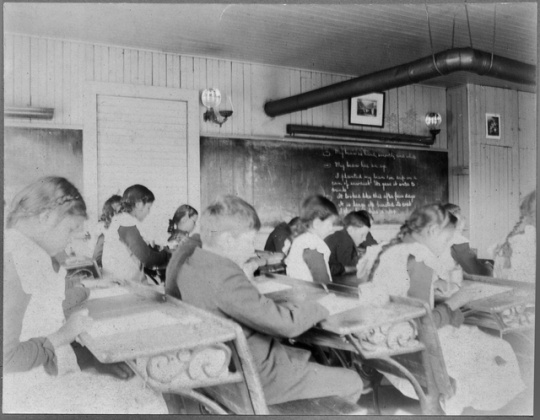
Native American boarding school in Beaulieu, Minnesota
“Intermediate” students inside a classroom at a boarding school in Beaulieu, Minnesota, c.1900.
Public domain
Holding Location
Articles
More Information
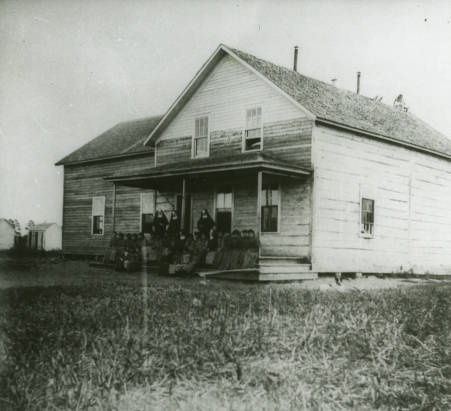
First school at St. Mary's Mission, Red Lake, Minnesota
First school at St. Mary's Mission, Red Lake, Minnesota, c.1880s.
Public domain
Holding Location
Articles
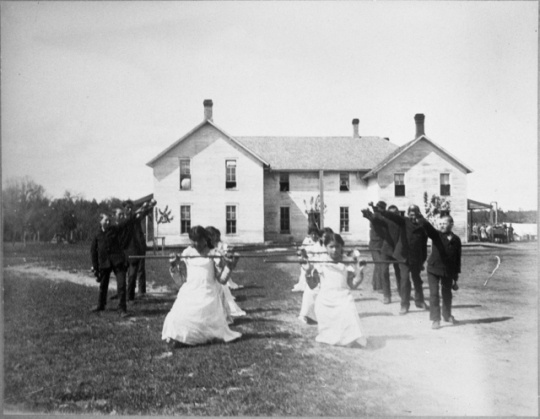
Students performing a drill on the grounds of a Native American boarding school
Students performing a drill on the grounds of a Native American boarding school, c.1890s.
Public domain
Holding Location
Articles
More Information
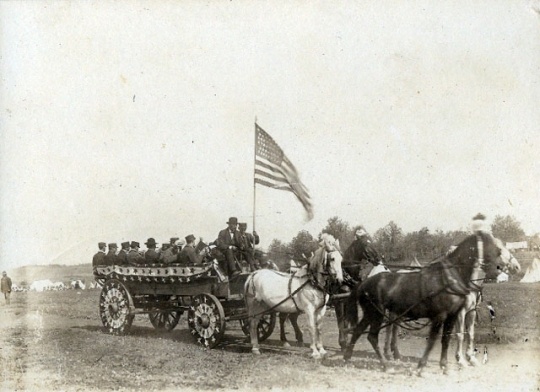
White Earth boarding school band
Members of the White Earth boarding school band photographed by the A. A. Richardson Photo-Illustrating Company between 1908 and 1916.
Public domain
Holding Location
Articles
More Information
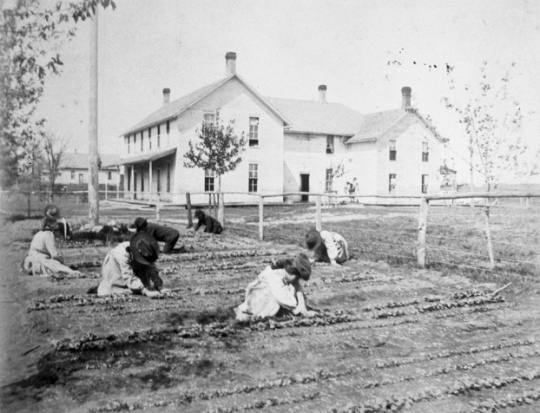
Children at an Native American boarding school work in a garden plot
Children at a Native American boarding school work in a garden plot, c.1890s.
Public domain
Holding Location
Articles
More Information
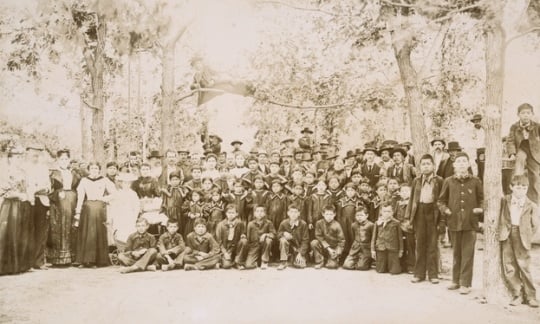
Students and staff of an Native American boarding school
Students and staff of an Native American boarding school, c.1900.
Public domain
Holding Location
Articles
More Information
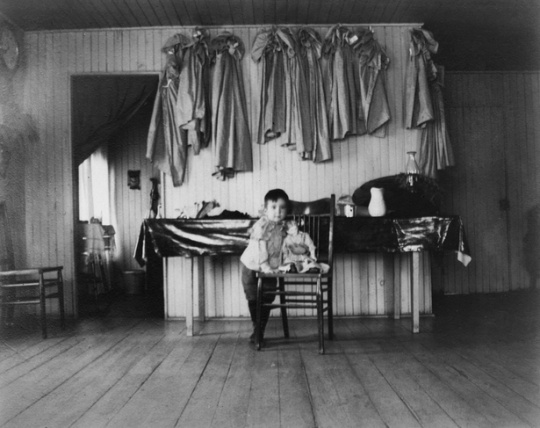
Child inside a Native American boarding school
A young child inside a Native American boarding school, c.1890s.
Public domain
Holding Location
Articles
More Information
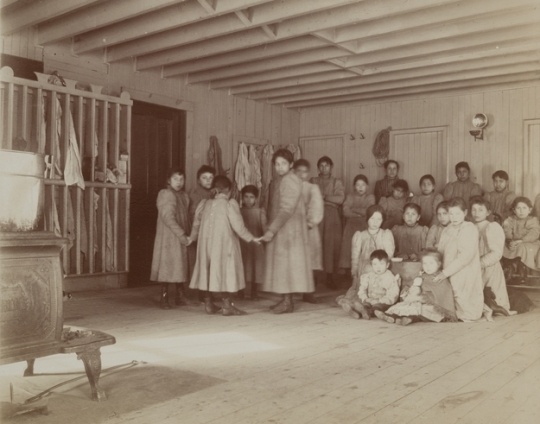
Native American boarding school students
Students at a Native American boarding school, c.1900.
Public domain
Holding Location
Articles
More Information
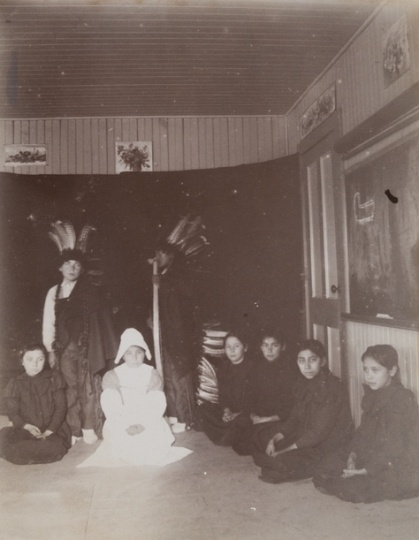
Thanksgiving play at a Native American boarding school
Students at a Native American boarding school perform a Thanksgiving play, c.1900.
Public domain
Holding Location
Articles
More Information
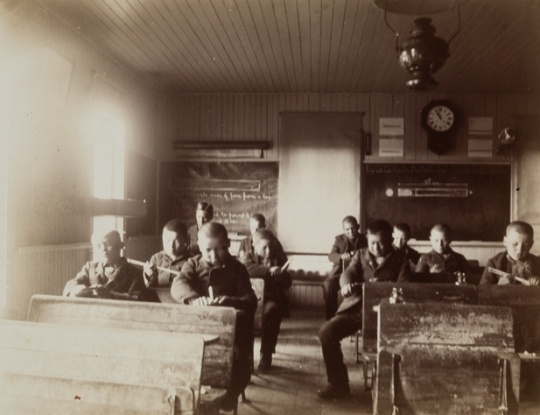
Native American boarding school classroom
Students inside a classroom at an Native American boarding school, c.1900.
Public domain
Holding Location
Articles
More Information
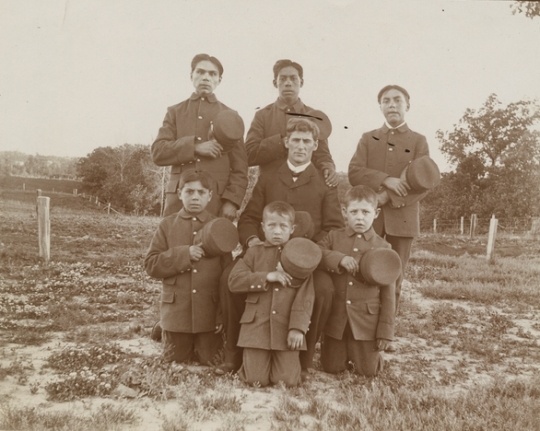
Native American boarding school teacher and students
Students and a teacher at an Native American boarding school, c.1900.
Public domain
Holding Location
Articles
More Information
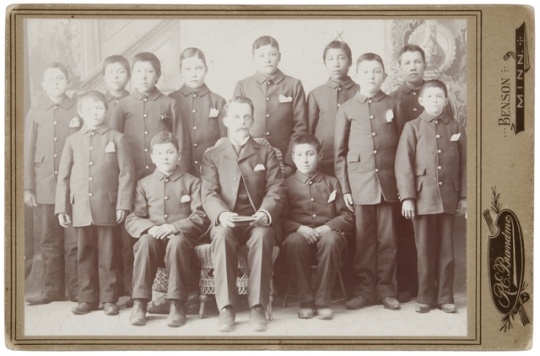
Teacher and students from Morris Indian School
Teacher and students, Morris Indian School, ca. 1895. Included are B. LeVivash, Joe Northrup, and Joe Siehy. Photograph by R. E. Brandmo.
Holding Location
More Information
Related Articles
Turning Point
After a 1928 report exposes overcrowding, malnourishment, and generally poor conditions for students in Native American boarding schools, the U.S. government begins to open day schools on reservations as an alternative.
Chronology
1869
1871
1879
1880
1891
1910
1928
1931
1970s
1985
2016
2021
Bibliography
Adams, David. Education for Extinction: American Indians and the Boarding School Experience, 1875–1928. Lawrence, KS: University Press of Kansas, 1995.
Archuleta, Margaret, Brenda Child, and Tsianina Lomawaima, eds. Away From Home: American Indian Boarding School Experiences, 1879–2000. Phoenix, AZ: Heard Museum, 2000.
Bah, Alberta Yeo. "Education Among Native Americans in the Periods Before and After Contact with Europeans: An Overview." Paper presented at the annual National Association of Native American Studies conference, Houston, Texas, 2005.
Child, Brenda. Boarding School Seasons: American Indian Families, 1900–1940. Lincoln, NE: University of Nebraska Press, 2000.
Cooper, Michael. Indian School: Teaching the White Man’s Way. New York: Clarion Books, 1999.
Feagin, Joe, and Clariece Feagin. Racial and Ethnic Relations. Englewood Cliffs, NJ: Prentice Hall, 2003.
Gunderson, Dan. "A Reckoning: St. Benedict Nuns Apologize for Native Boarding School." MPR News, October 26, 2021.
https://www.mprnews.org/story/2021/10/26/a-reckoning-monastic-order-apologizes-for-native-boarding-school
Horne, Esther, and Sally McBeth. Essie’s Story: The Life and Legacy of a Shoshone Teacher. Lincoln, NE: Bison Books, 1999.
Littlefield, Alice. "Learning to Labor: Native American Education in the United States, 1880–1930." In The Political Economy of North American Indians, edited by John Moor. Norman, OK: University of Oklahoma Press, 1993.
Lomawaima, Tsianina. "Domesticity in the Federal Indian Schools: The Power of Authority Over Mind and Body." American Ethnologist 20, no. 2 (1993): 1–14.
——— . They Called it Prairie Light: The Story of Chilocco Indian School. Lincoln, NE: University of Nebraska Press, 1994.
Pratt, Richard H. Battlefield and Classroom: Four Decades With the American Indian, 1867–1904. Robert M. Utley, ed. Norman, OK: University of Oklahoma Press, 2003.
——— . “The Advantages of Mingling Indians with Whites.” In Americanizing the American Indians: Writings by the “Friends of the Indian,” 1880–1900. Cambridge, MA: Harvard University Press, 1973.
Smith, Andrea. Conquest: Sexual Violence and American Indian Genocide. Cambridge, MA: South End Press, 2005.
Statutes at Large of the United States of America. 1891.
Trafzer, Clifford, Jean Keller, and Lorene Sisquoc, eds. Boarding School Blues: Revisiting American Indian Educational Experiences. Lincoln, NE: University of Nebraska, 2006.
Utley Robert, ed. Battlefield and Classroom: An Autobiography by Richard Henry Pratt. Norman, OK: University of Oklahoma Press, 2004.
Related Resources
Primary
I.65
Indian Boarding School, c.1900
Audiovisual Collection, Minnesota Historical Society, St. Paul
http://www2.mnhs.org/library/findaids/sv000053.xml
Description: Photographs taken at an unknown Indian boarding school, c.1900. The photographs depict students and staff, activities, and facilities.
Secondary
Berg, Carol. “Memories of an Indian Boarding School: White Earth, Minnesota, 1909–1945.” The Midwest Review 11 (Spring 1989)” 27–36.
Child, Brenda. “A Bitter Lesson: Native Americans and the Government Boarding School Experience, 1890–1940." PhD Dissertation, University of Iowa, 1993.
Fortunate Eagle, Adam. Pipestone: My Life in an Indian Boarding School. Norman, OK: University of Oklahoma Press, 2010.
Grover, Linda LeGarde. "From Assimilation to Termination: The Vermilion Lake Indian School." Minnesota History 58, no. 4 (Winter 2002–2003): 225–240. http://collections.mnhs.org/MNHistoryMagazine/articles/58/v58i04p224-240.pdf
——— . The Indian at Indian School. Little Rock, AK: Sequoyah Research Center, 2008.
Laliberte, David J. “Indian Summers: Baseball at Native American Boarding Schools in Minnesota.” Master’s Thesis, St. Could State University, 2008.
Shannon, James P. “Catholic Boarding Schools on the Western Frontier." Minnesota History 35, no. 3 (September 1956): 133–139.
http://collections.mnhs.org/MNHistoryMagazine/articles/35/v35i03p133-139.pdf
Wilcox, Alvin H. "History of the White Earth Reservation." Chap. XVIII in A Pioneer History of Becker County, Minnesota. St. Paul, Minnesota: Pioneer Press, 1907.
Web
Family Search. Pipestone Indian Boarding School.
https://www.familysearch.org/wiki/en/Pipestone_Indian_Boarding_School
City of Morris, Minnesota. Morris Indian Boarding School.
Originally found at: http://ci.morris.mn.us/mhrc/articles/mrsIndSchl.shtml
Mahnomen County, Minnesota. History.
Originally Found at: www.co.mahnomen.mn.us/history.html
"Native American Leader Dennis Banks on the Overlooked Tragedy of Nation's Indian Boarding Schools," Democracy Now October 8, 2012.
http://www.democracynow.org/2012/10/8/native_american_leader_dennis_banks_on
Red Lake Nation News: Red Lake History Project. Red Lake History 1900–1949.
www.rlnn.org/MajorSponsors/HistoryProject1900s.html
St. Benedict’s Monastery. Our History.
https://sbm.osb.org/community/
"St. Mary's Mission: Benedictine Sisters to Leave Red Lake After 121 Years." Bemidji Pioneer, June 20, 2009.
http://www.bemidjipioneer.com/content/st-marys-mission-benedictine-sisters-leave-red-lake-after-121-years













